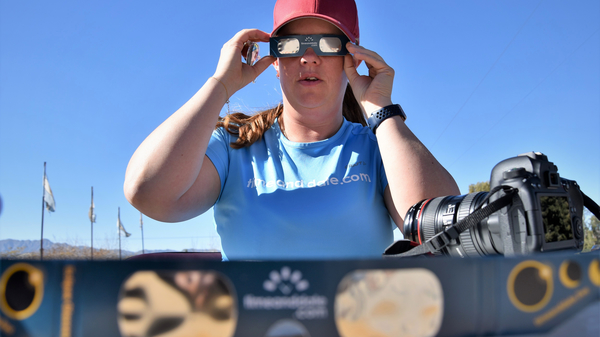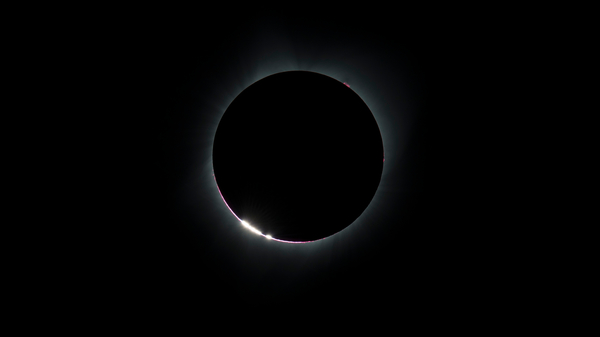How to Make the Best Use of Solar Eclipse Glasses
Four rules for using eclipse glasses—brought to you with the help of the world’s leading expert, Professor Ralph Chou.

Next Total Solar Eclipse: Mon, 8 Apr 2024 … See animation

timeanddate’s Anne Buckle checks her eclipse glasses.
©Anibal Heredia
LIVE: April 8, 2024: Total Solar Eclipse
During a solar eclipse, the Moon covers part of the Sun. But the brightness of the uncovered part of the Sun does not change. This can cause serious damage to the retina at the back of the eye. A solar filter or solar eclipse glasses must be used.
What are the eye safety rules for using eclipse glasses or handheld viewers? We talked to the world’s leading expert on injuries caused by solar eclipse viewing, Professor Ralph Chou at the University of Waterloo in Canada.
1. Know When to Use Eclipse Glasses
“You need to use eclipse glasses whenever the disk of the Sun itself can be seen,” says Professor Chou.
This means:
- All the time during a partial eclipse
- All the time during an annular eclipse—this includes the brief moments of annularity, when the Sun forms a dazzling ‘ring of fire’ around the Moon
- During the partial phases of a total eclipse
The following materials should NEVER be used to view a solar eclipse: sunglasses of any kind; color film; medical X-ray film; smoked glass; floppy disks.
2. Know When It Is Safe to Remove Eclipse Glasses
During the brief moments of totality during a total solar eclipse, the Sun is completely covered, and the ghostly solar corona becomes visible around the Moon.
For these few moments, eclipse viewers can be safely removed. (In fact, if you don’t take off your eye protection, you won’t be able to see the solar corona.)
The time to get ready to remove eclipse glasses is in the final seconds of Baily’s beads—when a few crumbs of sunlight flicker through valleys on the edge of the Moon.
“Wait until the crescent Sun is broken up into small beads of light along the edge,” says Professor Chou. “We don’t want any lengthy arcs of light. We want small points of light—as seen through the filter—before you remove eclipse glasses from your eyes.”
At the end of totality, when Baily’s beads appear on the other side of the Moon, eclipse glasses must be put back on.

The points of light known as Baily’s beads are named for the 19th-century astronomer Francis Baily.
©NASA/Aubrey Gemignani
A Tale of Two Eclipses
- The Great American Eclipse of October 2023 was an annular eclipse: at no time was direct viewing of the Sun possible
- The Great American Eclipse of April 2024 is a total eclipse: for people on the path of totality, safe viewing without any protective eyewear is possible during totality only
3. Make Sure Your Eclipse Glasses Are Safe
The international safety standard for eclipse glasses is ISO 12312-2, which applies to products intended for direct solar viewing. (Professor Chou is a member of the group that keeps this standard up to date.)
Unfortunately, some eclipse glasses are fakes: they say they are ISO certified (or CE certified in Europe), but they are not.
The only way to make sure you don’t have counterfeit eclipse glasses is to get them from a reliable and trustworthy source. The American Astronomical Society (AAS) has a list of reputable vendors, such as American Paper Optics, Rainbow Symphony, and Thousand Oaks Optical.
Before putting solar viewers on, check they are in good condition. If the filters or cardboard frame appear even slightly damaged, the eclipse glasses should not be used. “There may be more damage than you can actually see,” says Professor Chou.
One other piece of advice: “At almost every solar eclipse around the world, people try to buy eclipse glasses at the last minute, when they are all sold out. Buy early!”
Always read the safety information printed on the eclipse viewing glasses.
4. Practice Using Eclipse Glasses
To get the most out of an eclipse—and to avoid the risk of accidental exposure to the Sun—Professor Chou recommends that everyone practices using their solar eclipse viewers.
How to Use Eclipse Glasses
- Hold the eclipse glasses with two hands
- Stand with the front of your body toward the Sun, but look down
- Still looking down, put the eclipse glasses onto your face
- When they are securely fastened, raise your head and look up at the Sun
“Finally,” says Professor Chou, “don’t try to walk around with them on your face, because you can’t see anything.”
Solar filters should never be used with optical devices such as telescopes and binoculars, unless it is a specialist solar filter designed for use with that particular device. If you are uncertain about whether a filter is safe, do not use it. Avoid all risks.
Don’t forget you can also enjoy solar eclipses using pinhole projectors.